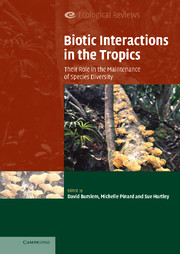Book contents
- Frontmatter
- Contents
- List of contributors
- Preface
- PART I Plant–plant interactions
- PART II Plant–microbe interactions
- PART III Plant–animal interactions
- PART IV Biotic interactions in human-dominated landscapes
- 18 The alteration of biotic interactions in fragmented tropical forests
- 19 Effects of natural enemies on tropical woody-plant invasions
- 20 New mix of alien and native species coexists in Puerto Rico's landscapes
- 21 The dynamics of a tropical dry forest in India: climate, fire, elephants and the evolution of life-history strategies
- 22 Changes in plant communities associated with timber management in natural forests in the moist tropics
- Index
- References
19 - Effects of natural enemies on tropical woody-plant invasions
Published online by Cambridge University Press: 25 August 2009
- Frontmatter
- Contents
- List of contributors
- Preface
- PART I Plant–plant interactions
- PART II Plant–microbe interactions
- PART III Plant–animal interactions
- PART IV Biotic interactions in human-dominated landscapes
- 18 The alteration of biotic interactions in fragmented tropical forests
- 19 Effects of natural enemies on tropical woody-plant invasions
- 20 New mix of alien and native species coexists in Puerto Rico's landscapes
- 21 The dynamics of a tropical dry forest in India: climate, fire, elephants and the evolution of life-history strategies
- 22 Changes in plant communities associated with timber management in natural forests in the moist tropics
- Index
- References
Summary
Plant invasions pose a current and increasing threat to species diversity and composition of forests worldwide. Biological invasions are natural ecological processes and the movement of plants across geographic barriers has always occurred (Sauer 1988), but humans have greatly accelerated the rate of introductions and moved plants across barriers that probably would not have been spanned naturally. Many of these plant introductions, whether deliberate or accidental, have had negative effects in the areas of introduction. Plant invasions have led to native species loss, altered ecosystem-level processes and caused enormous economic and environmental damage in various ecosystems, including tropical forests (Vitousek et al. 1987; Gordon 1998; Parker et al. 1999; Mack et al. 2000). Remote tropical islands and fragmented landscapes are particularly vulnerable to invasion by non-native plants (Laurance et al. 2002; Denslow 2003), but continental species-rich tropical rainforests also are invasible (Usher 1991; Rejmánek 1996a), particularly following natural or human disturbance (Whitmore 1991). Because of such negative impacts, species invasions are seen as one of the primary agents of global change (Vitousek et al. 1996), and tropical forests are unlikely to be immune (Fine 2002).
This chapter explores how biotic interactions, particularly herbivory and pathogen attack, may affect the abundance and distribution of invasive woody species in tropical rainforests. Specifically, I examine whether herbivores and fungal pathogens (natural enemies) are important determinants of species' abundance and distribution in their native ranges and whether the absence or reduced impact of these natural enemies may explain why certain introduced woody plants are successful invaders in tropical rainforests.
- Type
- Chapter
- Information
- Biotic Interactions in the TropicsTheir Role in the Maintenance of Species Diversity, pp. 459 - 483Publisher: Cambridge University PressPrint publication year: 2005
References
- 1
- Cited by



